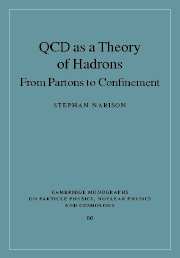Book contents
- Frontmatter
- Contents
- About Stephan Narison
- Outline of the book
- Preface
- Acknowledgements
- Part I General introduction
- Part II QCD gauge theory
- Part III MS-bar scheme for QCD and QED
- Part IV Deep inelastic scatterings at hadron colliders
- Part V Hard processes in e+e– collisions
- Part VI Summary of QCD tests and αs measurements
- Part VII Power corrections in QCD
- Part VIII QCD two-point functions
- Part IX QCD non-perturbative methods
- 40 Introduction
- 41 Lattice gauge theory
- 42 Chiral perturbation theory
- 43 Models of the QCD effective action
- 44 Heavy quark effective theory
- 45 Potential approaches to quarkonia
- 46 On monopole and confinement
- Part X QCD spectral sum rules
- Part XI Appendices
- Bibliography
- Index
40 - Introduction
from Part IX - QCD non-perturbative methods
- Frontmatter
- Contents
- About Stephan Narison
- Outline of the book
- Preface
- Acknowledgements
- Part I General introduction
- Part II QCD gauge theory
- Part III MS-bar scheme for QCD and QED
- Part IV Deep inelastic scatterings at hadron colliders
- Part V Hard processes in e+e– collisions
- Part VI Summary of QCD tests and αs measurements
- Part VII Power corrections in QCD
- Part VIII QCD two-point functions
- Part IX QCD non-perturbative methods
- 40 Introduction
- 41 Lattice gauge theory
- 42 Chiral perturbation theory
- 43 Models of the QCD effective action
- 44 Heavy quark effective theory
- 45 Potential approaches to quarkonia
- 46 On monopole and confinement
- Part X QCD spectral sum rules
- Part XI Appendices
- Bibliography
- Index
Summary
In the previous parts of this book, we have studied different methods based on power corrections, namely renormalons, instantons and the SVZ-expansion in terms of condensates and eventual quadratic corrections, which are one important aspect of non-perturbative QCD. In this part, we shall shortly discuss the other most popular non-perturbative methods used in QCD for studying the low-energy properties of the hadrons and of QCD. These are:
Lattice gauge theory
Chiral perturbation theory (ChPT)
Models of the QCD effective action
Heavy quark effective theory (HQET)
Potential approaches for quarkonia.
The method and phenomenology of QCD Spectral Sum Rules (QSSR) which will be discussed in more details will be devoted to a new part. Here, we do not aim to present a complete review and references but we shall limit ourselves to the outline of the general features of the different approaches. A more extensive list of non-perturbative methods, which will not be discussed here, such as the:
Skyrme model
Bag models
Discretized light-cone quantization
can be found in [3]. We shall shortly discuss in the chapter dedicated to the heavy quarks, the two approaches:
Potential and quark models
Stochastic vacuum model
Non-relativistic effective theories
which are discussed in details in some other reviews (see e.g. [51]).We shall complete this part by a short discussion on monopole and confinement.
- Type
- Chapter
- Information
- QCD as a Theory of HadronsFrom Partons to Confinement, pp. 395Publisher: Cambridge University PressPrint publication year: 2004



